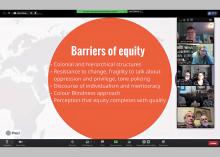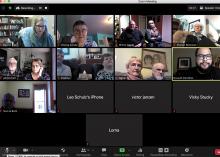When the death of George Floyd sparked race-related demonstrations across North America earlier this year, one of our deacons asked, “What can we do in response to this?”
My church, Eigenheim Mennonite in Rosthern, Sask., is racially homogeneous. The community beyond our church includes Indigenous, Filipino, Karen and Pakistani people, but they don’t worship with us. How could we, a group of white Mennonites, respond to the racial tension we witnessed daily in the news?
One response, we thought, would be to learn about racism, and we decided to do this through our adult education class.
Both Mennonite Central Committee (MCC) Saskatchewan and the Office of the Treaty Commissioner in Saskatoon supported us in our learning by providing speakers and facilitators.
Using Zoom as our platform, we met nine times between Sept. 13 and Nov. 22, with an average of 15 participants.
During our first sessions, we looked at the scriptural foundations for anti-racism and discussed words and phrases—such as “white privilege” and “white fragility”—that are common in conversations about racism.
In the following weeks, we welcomed five guest speakers. Their presentations were insightful, challenging and encouraging. I learned a lot more than I can include in a reflection piece such as this, but here are a few of my takeaways:
- Race is a social construct, invented to justify the enslavement of African peoples and the dispossession of Indigenous peoples worldwide. There are no significant biological differences between someone with white skin and someone with brown or black skin. But while race may be a fiction, racism is a reality.
- Whiteness and white privilege are also a reality, but we white people have been socialized not to see our privilege. We believe our possessions and our positions in society are ours because of our merits—because we worked for them. In fact, the advantages we enjoy are ours because others have been disadvantaged.
- There is a power dynamic inherent in racism that distinguishes it from prejudice. Anyone can be prejudiced against another group, but it isn’t racism if the person holding the prejudice is part of a marginalized group. In other words, there’s no such thing as reverse racism.
- “You don’t grow up with ‘my’ culture imposed on ‘you.’ There’s a power relationship there,” said Manuela Valle-Castro, who is the intercultural education coordinator with the Saskatchewan Intercultural Association and coordinator of the Saskatoon Anti-Racism Network. “You can’t call it racism until there’s that element of power, until there’s a group power attached to it. Racism is targeting whole groups on the basis of race.”
- One doesn’t become anti-racist overnight, or even after attending a nine-week course on anti-racism. Indigenous educator Russell McAuley spoke to us about anti-racism as “a lifelong process.”
- “It’s transformative rather than informative,” he said.
- Peace Akintade, a young Nigerian-Canadian poet, speaker and actor, told us that to be anti-racist is to “always be in a learning posture.” And that includes learning from our mistakes. When someone tells us our words or actions have been hurtful, she said, our best answer is, “I’m sorry. I didn’t know.”
- The role of white people in anti-racist work is important, but it isn’t a leadership role. People of colour are calling on us to learn about systemic racism and the racist history of our country. They’re calling on us to listen to their stories, follow their lead and walk alongside them in their struggle for racial equity.
- Roman Young is program coordinator for the Centre for Indigenous Women, Two Spirit and Gender Diversity with the Aboriginal Friendship Centres of Saskatchewan. He spoke to us about the importance of learning and building relationships with Indigenous people. “Educate yourselves. Gain deeper understandings,” he said. “You can learn and benefit a lot from each other. It’s a reciprocal relationship.”
- Understanding the concept of treaty is key to understanding anti-Indigenous racism. Indigenous peoples saw treaty as an agreement between two sovereign nations for the benefit of both. Amy Seesequasis, the Office of the Treaty Commissioner’s director of public education, told us that the creation of the Indian Act was a breach of treaty that resulted in the loss of culture, spirituality, traditions and languages for Indigenous peoples.
- “We’re over 150 years behind in our relationships because of the Indian Act,” she said. “We need to return to the principles of treaty. We are all treaty people.”
Our learning journey, which began with the question, “What can we do in response to this?” ended with a similar but more pointed question posed by Seesequasis: “How will you exercise your treaty identity and the responsibilities associated with it?”
I don’t know yet how to answer this question, but I do know that I can’t leave it unanswered.
Related stories:
White Mennonite static
Minority Mennonites organize a support group






Add new comment
Canadian Mennonite invites comments and encourages constructive discussion about our content. Actual full names (first and last) are required. Comments are moderated and may be edited. They will not appear online until approved and will be posted during business hours. Some comments may be reproduced in print.